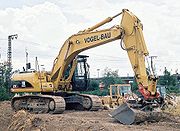
An excavator is an engineering vehicle consisting of an articulated arm (boom, stick), bucket and cab mounted on a pivot (a rotating platform, like a Lazy Susan) atop an undercarriage with tracks or wheels. Their design is a natural progression from the steam shovel.
Usage
Excavators are used in many ways:
* Digging of trenches, holes, foundations
* Material handling
* Brush cutting with hydraulic attachments
* Forestry work
* Demolition
* General grading/landscaping
* Heavy lift, e.g. lifting and placing of pipes
* Mining, especially, but not only open-pit mining
* River dredging
* Driving piles, in conjunction with a Pile Driver
Configurations
Excavators come in a wide variety of sizes. The smaller ones are called a mini-excavator or compact excavator. One manufacturer's largest model weighs 84,980 kg (187,360 lb) and has a maximum bucket size of 4.5 m³ (5.9 yd³). The same manufacturer's smallest mini-excavator weighs 1470 kg (3240 lb), has a maximum bucket size of 0.036 m³ (0.048 yd³) and the width of its tracks can be adjusted to 89 cm (35 inches). Another company makes a mini excavator that will fit through a doorway with tracks that can be adjusted to only 70 cm (28 inches) wide.
To identify the basic pieces, the cab attaches by way of a pin to the deck which holds the final drives which have a gear that drives the tracks. The Boom attaches to the cab by way of a large pin. Attached to the Boom is the Stick. Attached to the stick is the bucket and optionally, the thumb. Usually 2 large hydraulic cylinders create the lift of the boom. Some booms have a swivel capability so the boom can swing independent of the cab. The stick provides the reach along with the boom. Usually a model of excavator has optional lengths of stick that enhance either reach (longer stick) or break-out power (shorter stick). Bucket sizes and configurations are used for varying purposes. A wide "clean-up" bucket is used in situations where too much dig force would make the surfaces uneven. It "cleans-up" a site smooting and filling the ground. A "dig bucket" is much smaller. It usually has teeth on it to aggressively break into the ground. Buckets have numerous shapes and sizes for various applications. A "V-shaped" bucket can even penetrate ground that is frozen!
Excavator attachments
In recent years, hydraulic excavator capabilities have expanded far beyond excavation tasks with buckets. With the advent of hydraulic powered attachments such as a breaker, a grapple or an auger, the excavator is frequently used in many applications other than excavation. Many excavators feature quick-attach mounting systems for simplified attachment mounting, increasing the machine's utilization on the jobsite. Excavators are usually employed together with loaders and bulldozers. Most wheeled versions, and smaller, compact excavators have a small backfill (or dozer-) blade. This is a horizontal bulldozer-like blade attached to the undercarriage and is used for pushing removed material back into a hole. Prior to the 1990s, all excavators had a hang over, or "conventional" counterweight that hung off the rear of the machine to provide more digging force and lifting capacity. This became a nuisance in tight turn areas - the machine could not swing the second half of its cycle due to restricted turn radius. In the early 1990s The Komatsu Engineering Company launched a new concept excavator line that did away with the "conventional" counterweight design, and so started building the world's first tight tail swing excavators (PC128.PC138,PC228,PC308). These machines are now widely used though out the world.
From http://en.wikipedia.org/
Ear Force X41 (XBOX LIVE Chat + Wireless Digital RF Game Audio with Dolby
Headphone 7.1 Surround Sound)
-
Ear Force X41 (XBOX LIVE Chat + Wireless Digital RF Game Audio with Dolby
Headphone 7.1 Surround Sound)
by Turtle Beach
[image: Ear Force X41 (XBOX LIVE C...




0 comments:
Post a Comment